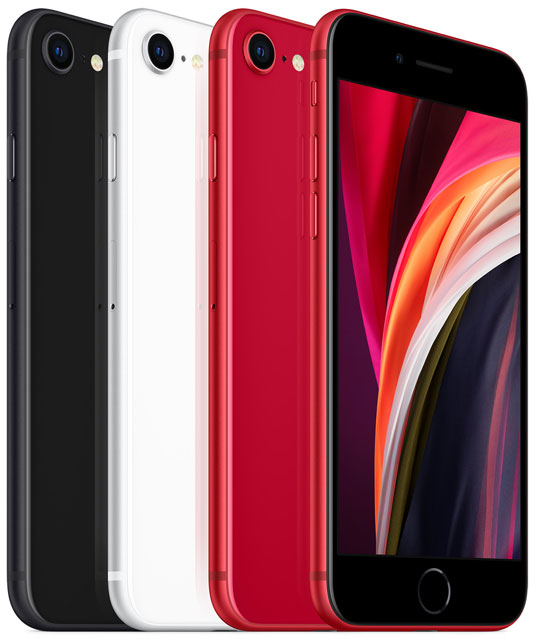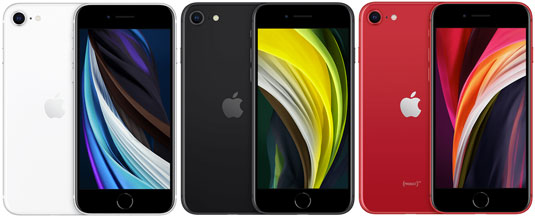Hosted by site sponsor WebMate.
iPhone Q&A
Update Published September 22, 2025
All Apple Q&As >> iPhone Q&A (Home)
To be notified of new Q&As, sign up for EveryMac.com's bimonthly email list.
What are all the differences between the iPhone SE (2nd Gen) models? How many are there around the world?
The iPhone SE 2 has been discontinued. However, this Q&A has been updated subsequently with current iOS support and other details and can be quite helpful for anyone buying or selling one of these devices on the used market.
If you assumed that the iPhone SE (2nd Gen) options differ only by color and capacity, you might be surprised that there actually are three different models that originally were sold in different places around the world. Each of these iPhone SE (2nd Gen) models were offered in three colors and three capacities (two capacities from September 14, 2021 to March 8, 2022, when it was discontinued).
To make differentiation easier, EveryiPhone.com more precisely refers to the three different iPhone SE 2 models as the iPhone SE 2 (4.7" 2020 United States/Canada), iPhone SE 2 (4.7" 2020 Global), and iPhone SE 2 (4.7" 2020 China).
Initially, it would have been unlikely to find more than one iPhone SE 2 in the same place, but as they fly around the world on the secondary market, it will be critical to understand the differences in network support and SIM compatibility, which are major. Understanding the similarities among the three iPhone SE (2nd Gen) models is worthwhile, too.

Photo Credit: Apple, Inc. (iPhone SE 2nd Gen)
External Similarities & Differences
All three iPhone SE (2nd Gen) models use the same external case design -- practically identical to the one used by the iPhone 8 -- primarily made from "low carbon" aluminum with a glass front and back. They are splash, water, and dust-resistant to the IP67 standard (maximum depth of 1 meter up to 30 minutes), but not fully waterproof.
The iPhone SE (2nd Gen) additionally has "wireless" -- or more precisely inductive -- charging capability, as well as stereo speakers, a Lightning port, a side-mounted Nano SIM access panel on the right side, and a solid state "clickless" Home button with integrated "Touch ID" fingerprint capability. The US/Canada (A2275) and Global (A2296) iPhone SE (2nd Gen) models support dual SIMs -- one physical Nano SIM and one digital eSIM -- but the model sold in mainland China (A2298) only supports a single Nano SIM.
The iPhone SE (2nd Gen) models all have two cameras. On the front is a 7 megapixel camera (f/2.2 aperture) with support for still photos and 1080p video. It has software support for Portrait mode and Portrait Lighting, but does not support Face ID. The rear camera is a single lens 12 megapixel wide angle camera (f/1.8 aperture) that supports optical image stabilization and takes still photos as well as 4K photos and video.
Additionally, the iPhone SE (2nd Gen) devices have the same 4.7" multitouch True Tone "Retina HD" display (1334x750, 326 ppi, 625 cd/m2 max brightness, 1400:1 contrast ratio). It supports haptic touch, but does not support 3D touch.

Photo Credit: Apple, Inc. (iPhone SE 2nd Gen Color Options)
All models have a black glass front and a glass back offered in three color options -- white, black, and (PRODUCT) RED.
Identification Differences
It can be a challenge to differentiate between the iPhone SE (2nd Gen) and earlier and later iPhone models, particularly because there are no specific external identifiers.
However, one relatively simple way to uniquely identify the iPhone SE 2 models is by the Model Number listed on the cardboard shipping box and within the iOS "Settings" app.
For the purpose of this Q&A, as diligently hand-documented by EveryiPhone.com, it is sufficient to note that the following model numbers refer to these devices:
iPhone Model |
Model No |
EveryiPhone.com's Ultimate iLookup feature also can precisely identify these iPhone models by Order Number (referred to as "Model" within the iOS "Settings" app under General > About), and their Serial Numbers, as well.
Wireless Connectivity & Data Differences
All three iPhone SE (2nd Gen) models support FTD-LTE bands 1, 2, 3, 4, 5, 7, 8, 12, 13, 17, 18, 19, 20, 25, 26, 29, 30, 34, 38, 39, 40, 41, 42, 46, 48, and 66 and TD‑LTE bands 34, 38, 39, 40, 41, 42, 46, and 48 as well as GSM/EDGE (850, 900, 1800, 1900 MHz), UMTS/HSPA+/DC‑HSDPA (850, 900, 1700/2100, 1900, 2100 MHz), 802.11ax Wi-Fi 6 with 2x2 MIMO, and Bluetooth 5.0.
Other connectivity differs accordingly:
iPhone Model |
Identifier |
Differing Connectivity |
LTE 14, 71 |
||
LTE 11, 21, 28, 32 |
||
LTE 14, 71 |
To reiterate, the US/Canada (A2275) and Global (A2296) models support dual SIMs -- one physical Nano SIM and one software eSIM -- but the model sold in mainland China (A2298) only supports a single Nano SIM.
Internal & Battery Life Similarities
All three iPhone SE (2nd Gen) models use a 2.66 GHz "A13 Bionic chip" with a 64-bit architecture as well as a "third-generation Neural Engine," have 3 GB of RAM, and the option of 64, 128, or 256 GB of flash storage (256 GB option discontinued on September 14, 2021). They each have an NFC (Near Field Communication) chip with reader mode to allow digital payments in conjunction with "Apple Pay" software, too.
All iPhone SE (2nd Gen) models provide as much as 40 hours of audio playback, 13 hours of video playback, and 8 hours of streamed video playback.
iOS Support Similarities
All iPhone SE (2nd Gen) models originally shipped with iOS 13, and later shipped with iOS 14 or iOS 15.
The iPhone SE 2 models also support iOS 16 with the exception of the minor Accessibility Detection and improved Depth of Field features; iOS 17, with the exception of the minor React with Your Hands; More Accurate Autocorrect in English, French, and Spanish; Inline Predictions (English); and Point and Speak features; and iOS 18, with the exception of the Apple Intelligence (AI), Messages via Satellite, Live audio transcriptions, Eye Tracking, and Music Haptics features.
Likewise, the iPhone SE 2 models support iOS 26, the current version of the iOS, but the minor 3D Effect Lock Screen feature as well as Apple Intelligence are not supported.
iPhone SE 2 Comparison Chart
These differences -- identifiers, network support, SIM compatibility, and target countries -- along with pricing details are summarized below:
| US/Canada | Global | China | |
| Model No: | A2275 | A2296 | A2298 |
| FDD-LTE: | 1, 2, 3, 4, 5, 7, 8, 12, 13, 14, 17, 18, 19, 20, 25, 26, 29, 30, 66, 71 | 1, 2, 3, 4, 5, 7, 8, 11, 12, 13, 17, 18, 19, 20, 21, 25, 26, 28, 29, 30, 32, 66 | 1, 2, 3, 4, 5, 7, 8, 12, 13, 14, 17, 18, 19, 20, 25, 26, 29, 30, 66, 71 |
| CDMA: | Yes | Japan Only | Yes |
| SIM 1: | Nano | Nano | Nano |
| SIM 2: | eSIM | eSIM | None |
| Region: | US/Canada | Global† | China |
| Orig. Price§: | US$399 US$449 US$549 |
£419 £469 £569 |
RMB 3,299 RMB 3,799 RMB 4,599 |
| Final Price§: | US$399 US$449 |
£389 £439 |
RMB 3,299 RMB 3,799 |
† This model was sold just about everywhere in the world except for the United States, Canada, and mainland China.
§ These prices are all unlocked and contract free. A variety of carrier subsidized plans, trade-in deductions, and lease options also were available.
In the US, site sponsor Other World Computing sells used and refurbished iPhone SE 2 models with free shipping. On the other hand, if you need to sell an iPhone, A+ BBB-rated Cash for Your Mac and GoRoostr will buy your older iPhone with an instant quote and prompt payment.
Please also see EveryiPhone.com's Ultimate iComparison feature to dynamically compare any iPhone model to any other iPod, iPhone, or iPad.
Permalink | Report an Error/Typo | Sign Up for Site Update Notices
<< iPhone Q&A (Main) | All Apple Q&As
Established in 1996, EveryMac.com has been created by experts with decades of experience with Apple hardware. EveryMac.com includes, and always has included, original research incorporating detailed, hands-on inspection of packaging, computers, and devices as well as extensive real-world use. All information is provided in good faith, but no website or person is perfect. Accordingly, EveryMac.com is provided "as is" without warranty of any kind whatsoever. EveryMac.com, and the authors thereof, shall not be held responsible or liable, under any circumstances, for any damages resulting from the use or inability to use the information within. For complete disclaimer and copyright information please read and understand the Terms of Use and the Privacy Policy before using EveryMac.com. Copying, scraping, or use of any content without expressed permission is not allowed, although links to any page are welcomed and appreciated.
